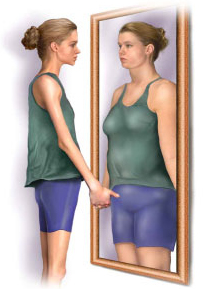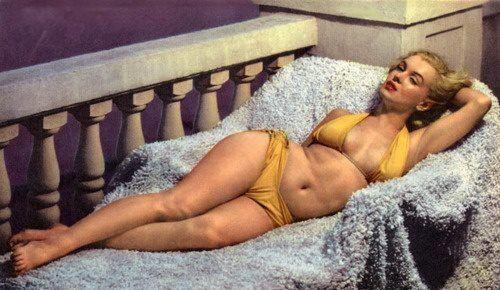This is something I have been thinking about for a very long time.
While we were in Europe we were blessed to be able to visit many different museums. I thoroughly enjoyed being able to see the beauty that was in them. What stood out to me the most was what was considered beautiful to people back then. Their were sculptures and paintings of women everywhere and not one of them were what we would now consider skinny.

Women of that time period were prized for their God given bodies. These paintings and sculptures, that I had the privilege of seeing, were focused on these women who today would be considered fat. However, back then, they were considered the height of sexiness.
What changed? Why is our perception of what is considered beautiful so starkly different, from even 50 years ago? Why is it that unless we as women choose to starve ourselves to death, we will never be remotely skinny enough to be considered 'beautiful', by ourselves or by the world? At five foot two, and weighing approx 117lbs I consider myself overweight. I see and feel every ounce of fat I carry on my body. I study myself in the mirror each day and am only able to focus on all of the things I want/NEED to change about how my body looks. All I want is to feel beautiful, but until I am 'skinny' I will never feel beautiful.
Women of the Renaissance period did not concern themselves with things like a few extra pounds of weight. In fact, just the opposite was true. The ideal beauty of that era was more voluptuous than perhaps any other time in history.
Why is it then, that when I look at myself, with my few extra pounds, that I can't see myself as beautiful like one of those women? Sometimes I wish I could go back in time.
The sad thing for me is that I am unconsciously teaching my kids to worry about how they look. I have tried really hard to not talk about myself in front of them, but I know they are aware of how I feel. I have heard my teenagers talk about how they think they are fat. How do I teach my children, especially my girls, to look at themselves as beautiful, just the way their Heavenly Father made them, with so many other people and things telling them different? I think each one of them is beautiful just the way they are. But without first changing my own opinion about myself, I think I will struggle to tackle the other things.
Here are some sad facts I found here :
- 95% of people who diet instead of following a healthy meal plan will gain back the weight they lose in between one and five years.
- 73% of teenage girls who abuse diet pills and 79% of teenage girls who self-purge frequently read women’s fitness and health magazines.
- At any given time, one in every three women and one in any four men are on a diet.
- 9/10 of girls who are high school juniors and seniors diet while only 1/10 of high school girls are overweight.
- Individuals who frequently diet often experience depression.
- 35% of individuals who diet only occasionally progress into pathological dieters.
- 2/5 of women and 1/5 would give up 3-5 years of their life to realize their weight loss goals.
- The diet and diet-related product industry boasts annual revenues of $33 billion.
- By 1990 the average age that a girl began dieting had dropped to eight from fourteen in 1970.
- Roughly one half of girls in 4th grade are on diets.
- More than half of nine and ten-year-old girls admitted that they felt better about themselves when dieting.

- Often, one of the first seating disorders symptoms to manifest is poor body image.
- According to a study from the University of Central Florida, nearly 50% of girls aged three to six were already concerned about their weight.
- A study showed that women experience an average of 13 negative thoughts about their body each day, while 97% of women admit to having at least one “I hate my body” moment each day.
- Roughly half of the women in the U.S. wear size 14 or larger though most standard clothing retailers only cater to sizes 14 and smaller.
- When asked to choose their ideal body shapes, 30% of women chose one that is 20% underweight while 44% chose an ideal body shape that is 10% underweight.
- A Glamour magazine survey showed that 61% of respondents felt ashamed of their hips, 64% felt embarrassed by their stomachs, while 72% were ashamed of their thighs.
- One study showed that women overestimate the size of their waists by 25% and hips by 16%, while those same women could correctly estimate a box’s width.
- One study showed that 75% of women consider themselves overweight when, in reality, only 25% were.
- Four out of five women in the U.S. are unhappy with their appearance.
- 81% of ten-year-old girls experience a fear of being fat.
- 42% of 1st through 3rd grade girls say they wish they were thinner.
- Adolescent girls are more afraid of gaining weight than getting cancer, losing their parents or nuclear war.
- More than half of white, adolescent girls who are a normal weight view themselves as fat.
- Seven out of ten women felt angrier and more depressed following the viewing of fashion model images.
- A study that offered preschoolers a choice between two dolls that were identical except for weight, the preschoolers chose the thinner doll nine out of ten times.
- Children were asked in one study to rate pictures of other children based on attractiveness. The obese child was rated less attractive than a child with a facial deformity, a child in a wheelchair and a child who is missing a limb.

- The majority of runway model meet the Body Mass Index (BMI) criteria to be considered anorexic.
- Vogue magazine stated that they chose Gisele Bunchen as their “model of the year” due, in part, to the fact that she deviates from the typical “rail thin” image. In fact, Gisele weighs only 115 lbs. and is 5’11 – 25% below her ideal weight.
- At 5’7 and 95 lbs. Kate Moss is 30% below her ideal weight.
- Fashion models’ weight averaged only 8% less than the average women 20 years ago. Today the average fashion model weighs 23% less than the average woman.
- 25% of Playboy centerfold models meet the criteria to be considered anorexic.
- Many magazines create images of women that don’t really exist by using computer-modified compilations of various body parts.
- Playgirl magazine centerfolds have grown increasingly muscular with less body fat over the last 20 years. However, the average man’s weight and body fat percentage have increased.
- Miss America contestants have grown increasingly thinner over the past three decades.
- Plus-sized models averaged between size 12 and 18 only ten years ago. Now, the majority of plus-sized models on agency rosters are between size 6 and 14.
- Mannequins closely resembled the shape of the average woman in the 1950s; the average mannequin and woman both had the hip measurement of 34 inches. Since then, there has been an increasing disparity between mannequins and the average woman. By 1990 the average hip measurement had increased to 37 inches while mannequins had decreased to 31 inches.
- Based on their theoretical body-fat percentages, most mannequins would cease to menstruate if they were real women.
- The average U.S. model weighs 117 lbs and is 5’11 while the average U.S. woman weighs 140 lbs. and is 5’4.

- One quarter of all television commercials convey a message related to attractiveness.
- The rate of eating disorders in Fiji surged following the introduction of Western television programming.
- A study found that viewing music videos featuring thin women correlated with a jump in body image dissatisfaction.
- In Allure magazine model and actress Elizabeth Hurley stated, “I’ve always thought Marilyn Monroe looked fabulous, but I’d kill myself if I was that fat.”
- Actresses Cameron Diaz, Julia Roberts and the singer Diana Ross meet the BMI criteria for anorexia.
- A People magazine survey showed that 80% of female respondents felt that women in movies and television programs made them feel insecure about their bodies.


